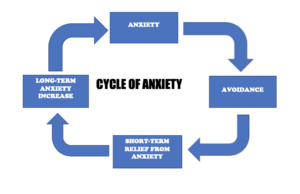Anxiety is natural and normal for people of all ages. It is a mental, physical, and emotional response to perceived threats that each person may experience to varying degrees and to different stimuli. As with all emotions, anxiety can be helpful in small doses – protecting from danger, providing awareness, and motivating to action such as completing homework assignments, not driving recklessly, or staying away from harmful substances. However, when experienced continuously or in extreme amounts, anxiety can cause unpleasant and unwanted mental, physical, and emotional symptoms. These include the following:
- Uncontrollable worry
- Poor concentration
- Heightened nervousness
- Avoidance of something causing fear
- Sleep problems
- Increased heart rate
- Muscle tension
- Upset stomach
When these symptoms (or symptoms like them) are experienced, there is a tendency to avoid the situation that led to feelings of anxiety. Examples of this include skipping classes to avoid another student or giving a presentation, using drugs or alcohol to avoid certain unwanted thoughts or feelings, and procrastinating doing something you don’t want to do but know you need to do. Avoiding anxiety results in an immediate sense of relief, but is temporary, and leads to a return of anxiety with elevated fear. The brain learns that when anxiety goes away, so do the symptoms, thus creating a cycle of anxiety.
For this reason, it is important that individuals find ways to manage and confront their anxiety to stop the cycle. There are many effective treatments for anxiety, including strategies that can be done at home.
Talk to your school counselor, psychologist, or social worker about finding treatment for anxiety or review our mental health provider list.
What is "treatment" for anxiety like?
Anxiety is typically treated through a combination of therapy, medication and/or relaxation skills. Here are some of the strategies used in therapy
- Cognitive Behavioral Therapy (CBT) –Challenging and changing unhelpful and/or irrational thinking and behaviors, improving emotion regulation, and developing coping strategies that target problem-solving.
- Exposure Therapy – Therapist and client make a plan to gradually introduce situations that create anxiety and increase exposure to it (systematic desensitization) over time, followed each time by relaxation skills.
- Acceptance and Commitment Therapy (ACT) – Identifying personal values and acting in ways that match them. It uses mindfulness and metaphors to gain control of negative thoughts and emotions.
- Eye Movement Desentization and Reprocessing (EMDR) – Client is asked to recall distressing images and the therapist directs the client to use bilateral sensory input, such as side-to-side eye movements or hand tapping.
What about medication?
Medication can help control the uncomfortable symptoms of anxiety but does not fix the underlying problems of anxiety. Thus, medication for anxiety should be used along with therapy and coping skills. A qualified doctor or psychiatrist can prescribe medication after a thorough evaluation. Follow-up visits are important to determine the effectiveness of medication use and possible changes.
Here are some simple relaxation techniques that can be done at home.
Several free apps can help students with a practice of mindfulness, meditation, or relaxation.
Check out these free meditation resources from Calm to help individuals manage anxious feelings related to these uncertain times.
Deep Breathing: When relaxed, it’s natural to take long, deep breaths using the stomach (belly breathing). However, when feeling anxious or panicked, the body will breathe shallowly and rapidly. Deep breathing sends messages to the brain that begin calming the body. Example: Square Breathing: Breathe in slowly for a slow count of 4, hold your breath for a slow count of 4, exhale for a slow count of 4, then hold again for a slow count of 4. Repeat until you feel calm.
Calming Imagery: Thinking about something that is calming and peaceful, such as a favorite location or scenario. If you really try hard to think about it and focus on what it’s like (mindfulness), you may begin to have feelings associated with it, as our brains have the ability to create emotions based on our thoughts. Make sure you’re in a quiet place so as not to get distracted. Think of a calming place such as being on a beach, in the mountains.
Progressive Muscle Relaxation: Tensing and relaxing muscles throughout your body can bring a sense of relaxation. It helps to relax the body through physical movement and to relax the mind by focusing on the task and the sensations experienced. Sit in a comfortable position or lie down. For each body area listed below, tense the muscle tightly but not to the point of pain, hold for 10 seconds, then release. Notice the difference between how it feels when tensed and relaxed.
- Feet – Curl your toes tightly into your feet, then let them relax
- Calves – Point or flex your feet, then let them relax
- Thighs – Squeeze your thighs together, then let them relax
- Buttocks – Squeeze together or flex tightly, then let them relax
- Torso – Tighten or suck in your stomach, then let it relax
- Chest – Flex your chest tightly, then let it relax
- Shoulders – Lift your shoulders up and backward, then let them relax
- Arms – Tighten your arm muscles, then let them relax
- Hands – Squeeze your hands into fists, then let them relax
- Face – Squeeze everything to the middle of your face, then let everything relax
- Full Body – Tighten everything together, then let everything relax, releasing all tension
Need more ideas?
- Check out this list of 50 strategies from Boys Town.
- This link has emotions worksheets, coloring pages, and feelings flashcards for free
- Emotion management resources curated by NBC news
- Childmind offers help with anxiety
- Worrywisekids has additional ideas
- Strategies from Coping Cats

